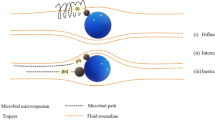Abstract
In situ observations have shown that underground storage of hydrogen behaves like a natural chemical reactor and generates methane. The mechanism of this generation is the metabolic activity of methanogenic bacteria which consume hydrogen and carbon dioxide and transform them into methane and water. The coupled mathematical model of the reactive transport and population dynamics in a storage is suggested in this paper which also takes into account the fact that the population growth rate depends on the structure of the bacterium colony. The suggested system of equations is reduced to the Turing reaction-diffusion model which proves the appearance of non-attenuating self-oscillations in time which are uniform in space. These solutions are unstable and, once perturbed, generate regular spatial stationary waves which correspond to the alternations of zones which are rich in CH4 or CO2. This result predicts the effect of a natural in situ separation of gases, which was observed in practice. If the diffusivity of bacteria is neglected with respect to the effective diffusivity of the injected gas, then only large-scale spatial waves arise. A low but non-zero bacterium diffusivity causes the appearance of additional small-scale linear oscillations whose period is the intrinsic parameter of the process and is proportional to the bacteria–gas diffusivity ratio. The analysis is completed with numerical simulations of 2D problems and analytical solutions of 1D problems obtained using the technique of two-scale asymptotic expansion. The estimations for the parameters of the model were obtained.
Similar content being viewed by others
References
Boone D.R.: Biological formation and consumption of methane. In: Khalil, M.A.K. (eds) Atmospheric Methane: Its Role in the Global Environment, pp. 43–59. Springer-Verlag, Berlin (2000)
Bulatov, G.G.: Undertground storage of hydrogen. Ph.D. Thesis, Moscow Gubkin Oil and Gas University 1979 (in Russian)
Buzek F., Onderka V., Vancura P., Wolf I.: Carbon isotope study of methane production in a town gas storage reservoir. Fuel 73(5), 747–752 (1994)
Carden P.O., Paterson L.: Physical, chemical and energy aspects of underground hydrogen storage. Int. J. Hydrog. Energy 4(6), 559–569 (1979)
Cole J.D.: Perturbation methods in applied mathematics. Blaisdell Publishing Company, Waltham, MA (1968)
Davison J., Arienti S., Cotone P., Mansuco L.: Co-production of hydrogen and electricity with CO2 capture. Energy Procedia 1, 4063–4070 (2009)
Flach E.H., Schnell S., Norbury J.: Turing pattern outside of the Turing domain. Appl. Math. Lett. 20(9), 959–963 (2007)
Gusev, M.V., Mineeva, L.A. (eds.): Microbiology. Moscow Lomonosov University, Moscow (1992) (in Russian)
Hurt D.: Hydrogen Power: The Commercial Future of the Ultimate Fuel. Financial Times Energy, London (1997)
Lindblom U.E.: A conceptual design for compressed hydrogen storage in mined caverns. Int. J. Hydrog. Energy 10(10), 667–675 (1985)
Merkin J.H, Needham D.J, Scott S.K.: On the creation, growth and extinction of oscillatory solutions for a simple pooled chemical reaction scheme. SIAM J. Appl. Math 47, 1040–1060 (1987)
Moosa S., Nemati M., Harrison S.T.L.: A kinetic study on anaerobic reduction of sulphate, part II : incorporation of temperature effects in the kinetic model. Chem. Eng. Sci. 60, 3517–3524 (2005)
Murray J.D.: Mathematical Biology. Springer, New York (1989)
Odencrantz, J.E.: Modelling the biodegradation kinetics of dissolved organic contaminants in a heterogeneous two-dimensional aquifer. Ph.D. thesis in civil engineering, Illinois (1991)
Panfilov, M., Gravier, G., Fillacier, S.: Underground storage of H2 and H2–CO2–CH4 mixtures. In: Proc. ECMOR-X: 10th European Conference on the Mathematics of Oil Recovery, 4–7 September 2006, Amsterdam, the Netherlands, Ed. EAGE, 2006, paper A003
Paterson L.: The implications of fingering in underground hydrogen storage. Int. J. Hydrog. Energy 8(1), 53–59 (1983)
Ponomarev-Stepnoi, N.N.: Nuclear-hydrogen energy, Kurchatov Institute, 2004. Available at http://rosatom.ru/vestnik/04/4/5.htm (in Russian)
Schnakenberg J.: Simple chemical reaction systems with limit cycle behaviour. J. Theor. Biol. 81(3), 389–400 (1979)
Sen N.K., Das D., Khilar K.C., Suraishkumar G.K.: Bacterial transport in porous media: new aspects of the mathematical models. Colloid Surf. A 260, 53–62 (2005)
Simbeck D.R.: CO2 capture and storage—the essential bridge to the hydrogen economy. Energy 29, 1633–1641 (2004)
Smigai P, Greksak M., Kozankova J., Buzek F., Onderka V., Wolf I.: Methanogenic bacteria as a key factor involved in changes of town gas in an underground reservoir. FEMS Microbiol. Ecol. 73, 221–224 (1990)
Strier D.E, Dawson S.P.: Role of complexing agents in the appearance of Turing patterns. Phys. Rev. E 69, 066207 (2004)
Svirezhev, Yu.M.: Nonlinear Waves, Dissipative Structures and Catastrophes in Ecology. Nauka, Moscow, 1987 (in Russian)
Taconi, K.A.: Methanogenic generation of biogas from synthesis-gas fermentation wastewaters. Ph.D. thesis in Chemical Engineering, Mississippi State (2004)
Taylor J.B., Alderson J.E.A., Kalyanam K.M., Lyle A.B., Phillips L.A.: Technical and economic assessment of methods for the storage of large quantities of hydrogen. Int. J. Hydrog. Energy 11(1), 5–22 (1986)
Turing A.M.: The chemical basis of morphogenesis. Philos. Trans. R. Soc. London, Ser. B B 237, 37–72 (1952)
Vavilin V.A., Lokshina L.Ya., Rytov S.V., Kotsyurbenko O.R., Nozhevnikova A.N.: Description of two-step kinetics in methane formation during psychrophilic H2/CO2 and mesophilic glucose conversions. Bioresour. Technol. 71, 195–209 (2000)
Zittel, W., Wurster, R.: Hydrogen in the energy sector. Laudwig-Bolkow Systemtechnik GmbH 7 (1996)
Author information
Authors and Affiliations
Corresponding author
Rights and permissions
About this article
Cite this article
Panfilov, M. Underground Storage of Hydrogen: In Situ Self-Organisation and Methane Generation. Transp Porous Med 85, 841–865 (2010). https://doi.org/10.1007/s11242-010-9595-7
Received:
Accepted:
Published:
Issue Date:
DOI: https://doi.org/10.1007/s11242-010-9595-7




